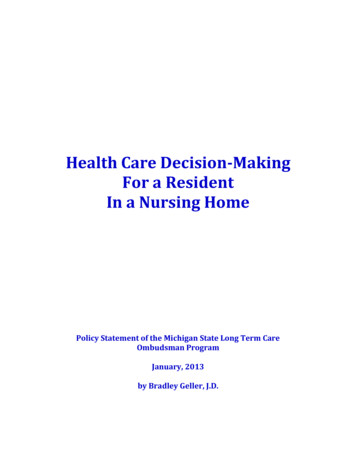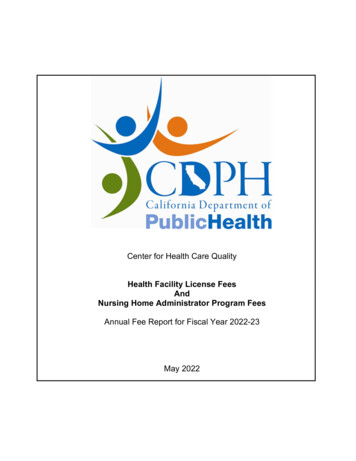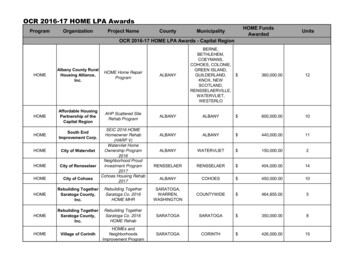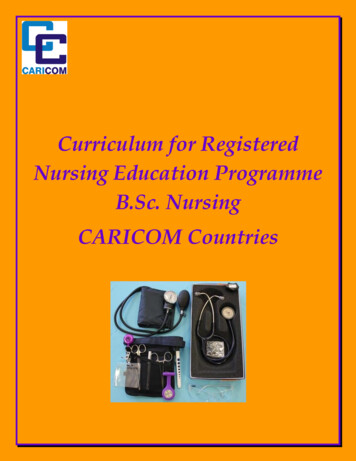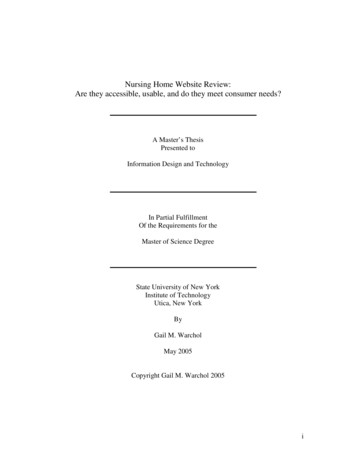
Transcription
Nursing Home Website Review:Are they accessible, usable, and do they meet consumer needs?A Master’s ThesisPresented toInformation Design and TechnologyIn Partial FulfillmentOf the Requirements for theMaster of Science DegreeState University of New YorkInstitute of TechnologyUtica, New YorkByGail M. WarcholMay 2005Copyright Gail M. Warchol 2005i
SUNYITDepartment of Information Design and TechnologyCertified of ApprovalApproved and recommended for acceptance as a thesis in partial fulfillment of therequirements for the degree of Master of Science in Information Design and TechnologyDateRussell KahnDirector MS IDTJoe Benincasa, MBA, Website DesignerSubject Matter Expertii
Abstract:This study addresses a two-part research question: Are nursing home websites easilyaccessible and used and do they offer enough information for consumers to makeinformed choices? Research indicated that generally, hospital discharge planners are theones who initially explain nursing homes to their patients with brochures and other hardcopy information. Some consumers, (generally family members of the patients) havevisited nursing home websites.A review of nursing home websites found that nursing home guide sites are often usedfor giving an array of information, including state survey results, quality assurance, staffratio, and occupancy rates. The internet users who were interviewed stated that nursinghome websites are often difficult to locate. Once having found the sites, intervieweesranked resident rights information as being most interesting, especially information onchoice-making and how they are treated once in the nursing home.iii
Acknowledgments:I would like to take this opportunity to thank the people that had input into this studyand those who had a positive effect on its completion. Dr. Russ Kahn assisted with theformalities of the study, including methods and theories. Dr. Kahn’s expertise in methodand theories used in various research, made it possible to narrow down choices made forthis quantitative grounded-theory study. Joe Benincasa was the subject matter expertthroughout the study. He was available on several occasions to discuss final findings andoffered suggestions for what needs to be done to make nursing home websites moreaccessible and usable. Dr. Paula Melville Baker read this study more than once andsuggested changes on design and layout. Thanks to all the nursing home administratorsthat sent back information and were available to discuss their websites’ pros and cons.Last, but not least, I would like to thank my children Mara and Michael, who supportedme throughout this study by allowing me to devote endless hours to the internet.iv
Table of ContentsAbstractiiiAcknowledgmentsvList of Figures / Tables / DiagramsviiiSection 1: Entry Vignette1Section 2: Introduction4Background5New York State Department of Health (NYSDOH) Regulations5Oneida County Background8Literature Review11Accessibility: Educating the Public and What Consumers Should Know11Usability: How Consumers Choose15Users: Who Uses Nursing Home Websites16Effectiveness: How Websites Are Most Effective17Problem Statement17Data Collection17Administration Questionnaires and Interviews17Oneida County Website Review18Resident & Family Interviews18Analysis of DataAdministration Questionnaires and Interview Analysis2222v
Section 2: ContinuedOneida County Website Review Analysis23Resident & Family Interview Analysis25Outcomes / Themes28Consumer List29Professional Team List29Section 3: Description of the Study and the Studied Contents30Section 4: Description of the Theory32Sense-Making35Human-Centered Design35Section 5: Detail about Selected IssuesDiscussion3737Section 6: Assertions39Ultimate Process41Study Limitations42Further Research42Conclusion43Section 7: Closing Vignette44Appendices:Appendix A: Glossary45Appendix B Information Consumers Want to know48vi
Appendices ContinuedAppendix C: Resident Rights50Appendix D: Health Care Proxy51Appendix E: Do Not Resuscitate52Appendix F: Ethics Permission Form53Appendix G: Interview Form54Appendix H: Questionnaire55Appendix I: New York State Scope & Severity Scale56References / Website References57vii
List of Figures / Tables / Diagrams:Figures:Figure # 1: Myziva.com Nursing Home Guide2Figure # 2: Nysdoh.com Nursing Home Guide20Figure # 3: Healthgrades.com Nursing Home Guide21Tables:Table # 1: Occupancy Rate5Table # 2: Twelve Core Topics14Table # 3: Oneida County Nursing Home Website Design Review16Table # 4: Yahoo / Google Searches20Table # 5: Data Collection Matrix21Table # 6: Oneida County Nursing Home Websites found22Table # 7: Website Data Matrix24Table # 8: Percent of Items Found25Table # 9: Choosing a Nursing Home32Diagrams:Diagram # 1: Consumer Current Process31Diagram # 2: Sense Making Triangle34Diagram # 3: Ultimate Process41viii
Section 1: Entry VignetteIt was early Monday morning in the middle of winter and Helen was sitting in hercottage in a town three hours away from her mother who lives in Oneida County. Helenis 58 and is the superintendent of a small school district downstate. Her mother livesupstate and is in her eighties. Recently, Helen received a call from her mother, Sally, whosaid that she was having difficulty getting around. Helen knew that her mother wasforgetting to take her medication properly and was not eating the way she should. Helenreassured her mother that she would call a neighbor to assist her during the week but thatHelen would be up on the weekend to be with her.Nursing home placement had been approaching for almost a year. Besides not eatingwell and forgetting to take her medication, Sally had missed several doctor appointmentsin the past few months. Both Sally and Helen decided it was time to stop putting off thesearch for nursing home placement.Helen asked her mother what was important to her, where she would like to live, howmuch she wanted to spend, and what activities interested her the most. Helen wanted toknow if she would lose certain rights once admitted to a nursing home. She asked aboutrecreation and religious services. Helen had concerns of her own: quality of care,department manager’s names and extensions for accountability, building layout, and howthe nursing home was rated on the latest state survey.Being unfamiliar with nursing homes in Oneida County and not knowing particularwebsite addresses, Helen decided to start with Microsoft Explorer on the Internet. Whenshe typed in “Oneida County Nursing Homes” a list of nursing home guide sitesix
appeared. Helen chose the first on the list myziva.com (see Figure #1). She had to simplytype the zip-code or county, of the nursing homes’ locations. After entering the zip-codeor county a list of all the nursing homes in that location alphabetically appeared. Withinseconds, Helen was able to view a variety of information on all the nursing homes inOneida County. Myziva.com offered the latest survey results, the address and phonenumber of each facility, staff ratio, and how the nursing home compared to other nursinghomes statewide. This site answered some of the questions Helen and Sally had but didnot provide information about activities, room rates, or resident rights.Figure #1: Myziva.com Nursing Home Guidewww.myziva.netONEIDACOUNTYOne of the Nursing Home Guide sites used in this studyHelen and Sally decided to consider three of the homes by their ratings and by theirlocation. Helen then tried to find out if these three nursing homes had websites of theirown. This took more than a few seconds. Actually, it took a few hours. Helen found someof the sites easily. For others, she had to call the phone numbers that she had found onx
“myziva.com” and ask the nursing home staff for the web addresses. Some of the nursinghomes didn’t have websites and the ones that did have websites listed some of theinformation that Helen and her mother were looking for, but not all. Helen stated at onepoint, “If the nursing homes website address was what you might think it would be, it waseasier to find, but some addresses were totally different from what the nursing homenames themselves and were hard to find.”Helen found her experience frustrating for two reasons. One was the time it took toactually find website addresses for nursing homes. The second reason was the lack ofinformation she and her mother had hoped to find. For Helen and Sally, it was importantto find out about such things as meal menus and activities. None of the sites Helenreviewed posted a monthly activity calendar or a monthly menu. It was also difficultwhen Helen called the homes, as the sites did not offer individual contact names. “Manywebsites did not go into the detail about the services offered or the staff responsible forthe services. They provided no faces or names for key management staff or how tocontact them.” For Helen, using websites was helpful for getting initial baselineinformation, but how she and her mother actually chose a home was through an on-sitetour.This family’s experience of looking for nursing home websites illustrates key issuesthat will be the subject of this research: talking to family members, it was clear that thisstudy needed to focus both on what information should to be provided in a nursing homewebsite, and on how accessible site addresses should be, and how to make sites availablevia search engines.xi
Section 2: IntroductionA grounded-theory approach was use to examine the relationship between theconsumer and the nursing home websites themselves, i.e. the action taken by theconsumers to access a website; the interaction when the consumer gets to the website (isthere sufficient relevant information?); and the process that might be used by a nursinghome to determine if the particular website design meets consumer needs. The studyexplores what information should be included when creating a website. Twelve coreareas with 43 items of what should go into a nursing home website are discussed.Information was compiled from a combination of literature review and resident familyinterviews. The study also explores how consumers look for nursing homes on the WorldWide Web. Where do they go first? How far will consumers go to look for what theyneed? The study touches on what administrators and market planners think of their sitesand why the sites were designed in the first place. The geographical area covered in thisresearch is Oneida County, in upstate New York. The study started by inviting all nursinghomes in the county to participate. A search was completed on the internet by typing inOneida County nursing homes, much like Helen did in the vignette when she started hersearch. Names, addresses, and phone numbers were kept in a journal. A questionnairewas sent to all 17 nursing homes in the county asking for information about such items asthe purpose of the site (see Appendix H). Those nursing homes that do not have websiteswill not take part of this study. Each nursing home was assigned a number and will bereferred to by that number to respect and protect confidentiality. Of the 17 nursingxii
homes in the county, 11 have websites. These eleven sites were looked at a number oftimes throughout the study for content and design.Website use is the newest form of media in the nursing home industry. Other systemsused in marketing nursing homes include but are not limited to: discharge planners,yellow pages, television broadcasting, radio broadcasting and brochures. None of thenursing home administrators know if the use of websites increase occupancy rate or not.However, data collected from a nursing home guide website indicates website use mayhave an impact on occupancy rate (see Table # 1). Occupancy rate of course, may haveto due with location. Of the six nursing homes without websites, five of them were foundto be located in the same geographical area of the county. Four of these five homes arefor-profit homes. Of the eleven nursing homes with websites ten of them are non-profit.Table # 1: Occupancy Rate:Nursing Homes# of BedsOccupancy RateNH with Websites (11)199596%NH without Websites (6) 58083%Total89.5%(17)2575Table comparing occupancy rates at nursing homes with and without websites.Background:New York State Department of Health (NYSDOH) Regulations for Nursing HomesThe New York State Department of Health surveys nursing homes annually.Regulations are set forth as a way to ensure proper care and treatment. According to onenursing home administrator, how people treat others in our society requires governmentxiii
security and intervention. For some, treating people with dignity and respect comeseasily. Others need guidelines and mandates set forth by state and federal officials.NYSDOH survey teams have a 216 page regulation booklet to follow when completingtheir annual surveys of skilled nursing facilities. Each section is set up by tag numbersand gives the survey team guidelines of how health care professionals should be runningtheir nursing homes. For the purpose of this study, the main sections will be listed to givethe reader some idea of what is included in the regulation process. In essence these samecategories are what consumers should be looking for when choosing a nursing home,According to “American Association of Homes and Services for the Aging”. These tagswere developed through the years and have become a way for administrators to set thestage in nursing homes. Administrators, directors of nursing, and other managers arerequired to run their nursing homes according to these regulations, as their operationalbaseline for quality assurance. The main categories of the requirements are, ResidentRights, Admission, Transfer and Discharge, Resident Behavior and Facility Practices,Quality of Life, Resident Assessment, Quality of Care, Nursing Services, DietaryServices, Physician, Services, Rehabilitation Services, Dental, Services, PharmacyServices, Infection Control, Physical Environment, and, Administration. There arehundreds of tags that fall within these headings. Regulation tags are defined andmeasured on a scope and severity scale. A copy of the scale is shown in Appendix H.According to a number of administrators and families a negative survey can reduceapplications to the nursing home. One family member used survey results found on theweb as a guide to choose a home for his mother. He looked at the information beforetaking an onsite tour. He never once looked at the individual nursing home websites. Hexiv
said, “The ones with undesirable survey results were not a consideration.” He said “If anursing home causes actual harm to their residents it’s not a place for my mom.”How do nursing home guide sites get their information? The NYSSDOH lists on theirwebsite the survey results for each home. The information is then pulled from the statewebsite by nursing home guide websites, such as www.myziva.net. The results sharefacts with no detail of the circumstances that lead to the deficiency. Take pressure areas(bed sores), for instance: a home could get a level G for not preventing or healing apressure area. What is not told on these sites is whether or not the person was admittedwith such a problem to begin with, or if the person was breaking down because of otherhealth related issues. A level “L” can mean widespread death. In such a case the nursinghome is at risk for closure and the chances of someone choosing such a home are null.Family members seeking placement for their relative would very likely skip placement ina home that had negative survey results. As reported deficiencies take a long time torecover from, a nursing home’s reputation is important.Do nursing home websites offer potential consumers enough information to makeinformed decisions when choosing which skilled nursing facility? How do people makesuch a decision? According to Openseason:“Selecting a nursing home is one of the mostimportant and difficult decisions that you may be asked to make either for yourself or fora member of your family. So it’s important that you base your decision on the mostcomplete and timely information available” (Openseason 1). Besides hospital dischargeplanners and websites, word of mouth drives people to consider choosing a specificnursing home. According to residents and their families, whether they used the internet ornot, word of mouth counted, in part, toward their final choice.xv
Family members stated that websites would be one way to advertise and create a goodreputation, especially if the survey results were favorable. Mark is a retired nursing homeadministrator, who had used Yahoo as a search engine to browse for a nursing home forhis mother. He needed to actually telephone the nursing homes to get his questionsanswered, especially regarding financial information. Mark said this was frustratingbecause he feels that websites should give all information needed by a consumer. He saidthe consumer should not have to telephone the nursing home if it has a website. Also,nursing home websites should be designed so that consumers can schedule onsite tours.Mark utilized the scope and severity scale that was posted on the nursing home guide site.This scale takes into account all aspects of quality of life and quality of care issues. Henarrowed his search down by the information provided on the guide sites.When the state surveyors evaluate a resident’s medical record, they use the scope andseverity scale to determine the severity of the deficiency. The higher the letter, the moreat risk the residents are, as mentioned previously. The scale ranges from letters A throughL with “A” the “least harmful” and “L” the “most harmful”. The scope ranges frompotential minimal harm to immediate jeopardy. There is no description of how the scopeand severity scale works on nursing home guide websites.Oneida County Background:Oneida County has 17 skilled nursing facilities within various cities and towns. 11 ofthese nursing homes have websites. The terms “skilled nursing facility”, and “nursinghomes” will be used interchangeably throughout this paper. According to administratorsinterviewed, they feel that for now, Oneida County has enough nursing home beds tosatisfy the number of people in need, as indicated by occupancy rates (see Table # 1).xvi
This may change, with the fast growing elderly population. According to the UnitedStates Census, since 1960, the population group 65 and older has grown 89% while thetotal population has increased only 39%. The United States census shows that the fastestgrowing segment of the elderly population (65 and above) is the segment age 85 andabove. What does this tell us? It tells us that people are living longer. In 1900, lifeexpectancy in the United States was 47; years of age, in 1996, life expectancy rose to75.8 years of age.According to American Association of Homes and Services for the Aging: Choosing aQuality Nursing Home, the elderly need to be informed and have a variety of sourcesavailable when considering a nursing home. People rely heavily on hospital dischargeplanners to provide quick answers to general questions that they may have. According tohospital discharge planners and administrators, hospital personnel have their ownprocedures for discharging patients, with the obligation to discharge them safely.Unfortunately they said, the patient or caregiver is in an acute situation at the time and isrelying on hospital discharge planners to find a skilled nursing home that fits individualneeds. Sometimes, the person needs rehabilitation after a stroke or hip replacement andthe hospital discharge planner gives a list of nursing homes within a 50 mile radius. Thisis a practice indicated by New York State Medicare / Medicaid regulations(www.assistguide.com). These hospital discharge planners also give guidance to elderlypeople for continuing care, known as permanent placement, for such diagnoses asdementia or physical limitations that therapy can’t undo.Administrators and other healthcare providers stated that post-op patients and postacute patients are more focused on getting well than trying to figure out what a nursingxvii
home offers. Hospital discharge planners help people find a suitable skilled nursinghome. Family members interviewed said their parent felt rushed through the nursinghome admission process. Families said they tried to help but indicated they had no ideawhat to look for. They said it would be helpful to have a list of things they should knowprior to being admitted to an acute care setting. At the time mom was ill and sub-acutecare was needed, one family said they needed somewhere for mom to go, to be safe andwell-taken care of. The family member worked full time and could not care for theirmother at home. Another family member said that dad felt “bewildered” the first fewdays he was admitted to a local nursing home. Questions came up after admission thatshould have been asked prior to admission. He said, “The problem was that we didn’tknow what types of questions to ask, which left us feeling unsettled from the start”.According to Bernie Khoo, writer of “To better position your facility, create awebsite,” nursing home websites are becoming popular and are an efficient way to get avariety of information in a short amount of time, but the research found that the majorityof nursing home consumers don’t utilize websites. Kooh writes that nursing homewebsites typically lack sufficient information for people to make informed choices. Thisstudy studies what consumers want and need on nursing home websites. The topic wasresearched using articles and journals published by state and federal agencies, written byadvocates for the elderly, and appearing in scholarly journals. This information waschecked against Oneida County nursing home websites. The content of each website wascross-referenced with a list of recommended questions (Harrington 2003, Top TenNursing Homes 2003, Open-Seasons 2004, California Resistry 2003, and Bentley 2003)that should be answered prior to choosing a nursing home. Resident’s and their families,xviii
nursing home administrator’s, nursing home marketing staff, were interviewed for thisstudy, and residents and families were observed using nursing home web sites.Literature Review:Accessibility: Educating the Public & What People Should Know:According to American Association of Homes and Services for the Aging (Choosing aQuality Nursing Home 2004), a quality nursing home should offer a list of key personnel,as well as dietary, therapeutic, social, recreational and nursing services. Skilled nursinghome websites generally list services available in each facility, but there is otherinformation that allows a person to make an informed choice. Oneida County nursinghome websites advertise services available for the elderly, but through interviewingfamilies and observations some of the websites didn’t offer important information, or theinformation was hard to find. Information families were looking for include: residentrights information especially choice making, quality of care standards and financialinformation, such as room rates and co-payments after Medicare and other insurancereimbursement. Family members found services offered and ways to contact the facility,but couldn’t find other information such as choices in everyday living and other civilrights information such as the right to vote.The association guidebook notes that it wouldn’t be unusual for a patient to overlookmeal schedules, or phone and TV expenses, when considering admission to a nursinghome for a short term stay. For example, as long as the admitting facility is known tooffer good rehabilitation services (physical and occupational therapy), that satisfies themain concern. Once the uninformed patient is admitted to the nursing home, they mayfind out that phone and cable access carry additional charges. One family member statedxix
that “dad started having second thoughts about his stay at one area nursing home andalmost transferred to another nursing home because important financial details had beenoverlooked. Another family member stated that their mother was admitted fro physicaland occupational therapy but therapy only took an hour or two out of the day, momstarted getting “board” for the first few days because she was unaware of activitiesoffered in the home. According to Bentley (36) [Residents that are well informed aregenerally happier and have a better overall outlook about their nursing home stay,opposed to those less informed.]“People can be educated by using websites”, according to “Educating the families ofnursing home residents (133).” This study took place in various nursing homes inPittsburg, PA. The article was published in the May-June 2003 issue of the Journal of theAmerican Medical Directors Association and says its goal was to educate 18 residents’families on the diagnosis of dementia, in order to enhance their participation in nursinghome care. These family members were the residents’ decision makers. They learnedabout how dementia can become problematic, as far as a resident’s behavior: wandering,agitation, etc. Family members, generally speaking, have a hard time admitting thatGrandma is tripping down the hallways yelling foul language. Families may give staff ahard time about “Grandma’s” plan of care. The Pittsburg study was to educate families sothat staff and families could agree on an effective care plan. The education process wascompleted by using a computer web-based system. The families were asked 16 pretestquestions. They were shown information on dementia, and focus groups were held forinteractive communication prior to the posttest of 16 questions. This study primarilyfocused on family involvement with care planning issues, so that staff and familyxx
members were on the same page, but it also was done to get families more involved in aresident’s daily routine. This study was trying to bring residents, families, and staff alltogether to find some sort of common ground to helped families better understand thedisease and to reduce confrontation between staff and family members. The study foundthat family members could be educated on dementia using web-based systems and groupinteraction.According to Just What the Consumer Needs? (Jan / Feb 2003 American Journal ofMedical Quality), residents and families can be educated by using Federal and StateNursing Facility Websites (23). The article describes the content of federal and statenursing home websites. It looks at a variety of Federal and State nursing home websitesin 24 states and the District of Columbia. The sites presented the facilities’ characteristicsand listed their latest survey results. However, few sites offered data on ownership,staffing, quality of care, complaints, and enforcement actions. According to the article,resident characteristics, staff turnover rates, and costs were generally not available to thepotential consumer.To Better Position your Facility, Create a Website, Khoo1999 (47) concludes thatsome research says creating websites is important to staying competitive. The study saysthat like any business, a website takes up both resources and employee time. If thewebsite fails, it should be eliminated. The study agrees with other research, in statingconsumers and their families value expressions of caring and the availability of residentchoices rather than expertise in services provided. The study says that most often nursinghomes are dealing with families of seniors rather than the senior themselves. Familymembers interviewed said that the website should be user-friendly, use large font sizes,xxi
and also make sure that the contrast between text and background is effective for seniorsand their families. Flowery backgrounds make it difficult for seniors to grasp the text sothat they may skip over important information presented. Make sentences short anduseful. The front page should be created with an atmosphere like your front lobby. Khoosuggests that this will attract the consumer, so that they will look deeper into you website.The Guide (Openseasons.com) “Choosing a Nursing Home” recommends to having acheck-off list of things to look at when a reviewing nursing home website. The first thingon the check-off list is “Do you need a nursing home?” or is adult or assisted livinghomes more appropriate. Are area websites offering options to people requiring a lesserlevel of care? Openseasons also said to make sure the resident and / or the patient’sfamily takes a tour of the facility they’re interested in. Do nursing home websites offerthis visitation as a choice to the potential customer? Table # 2 list the twelve core topicsthat they said were popular with consumers.Table # 2: Twelve Core Topics for a Nursing Home Website Certification of Operation and Key Personnel(Harrington 2003)Longevity of Key Personnel (Top Ten Nursing Homes 2003)Contact Information ( Top Ten Nursing Homes 2003)Financial Information (Harrington 2003)Quality Assurance (Harrington 2003)Staff/Resident Ratio (Harrington 2003)Building/Grounds/Safety (Open-season 2004)Special Programs/Activities (Top Ten Nursing Homes 2003)Dinning( California Registry 2003)Health & Personal Care (Bentley 2003)Resident Rights (Bentley 2003)Admission & Discharge Criteria (Harrington 2003).Information people should be looking at when choosing a nursing home.xxii
Usability: How Consumers ChooseAccording to Bentley, in the article “Older people as Health Service Consumers”,nursing home candidates express that control of their lives is what is important to them.Older people want to be offered choices and the right to have a say in everyday lifeincluding meals, activities, and finances. Self-expression and having their voices heardand taken seriously are important. Quality of life issues are addressed by the New YorkState Department of Health when doing their annual survey. Bentley also stated
visited nursing home websites. A review of nursing home websites found that nursing home guide sites are often used for giving an array of information, including state survey results, quality assurance, staff ratio, and occupancy rates. The internet users who were interviewed stated that nursing home websites are often difficult to locate.







